![]()
The Cassini/Huygens mission, which returned iconic images of Saturn and its moons for more than a decade, was supported by a range of ground-based optical observatories and techniques. [Image: NASA]
By the time you read this, the two-decade-old Cassini/Huygens mission—arguably one of the most successful planetary explorations in history—will have officially drawn to a close. Indeed, you may have been among the audience of thousands who watched the real-time video stream as the Cassini probe made its final plunge into the atmosphere of Saturn, a digital-era media event all but unimaginable when the probe was first launched into space in 1997.
In light of all it has accomplished, the current focus on the intrepid Cassini spacecraft is entirely appropriate. Yet there’s also another story: that of the ground-based observations, and the scientists making them, that supported Cassini through its long journey. These Earthbound explorers took advantage of cutting-edge optical tools and techniques to deepen and enrich Cassini’s scientific haul, and to help out at crucial moments. And they’ll continue the journey long after the spacecraft’s demise.
Smart, but not omniscient
To be sure, the Cassini spacecraft itself was tricked out with an array of optical instruments and remote-sensing tools. These included its Composite Infrared Spectrometer (CIRS); various systems for visible and UV imaging and spectroscopy; microwave-band tools for mapping Saturn’s rings and the surface of its moon Titan; and gadgets for analyzing plasma, magnetic fields and captured dust particles.
The assemblage allowed Cassini/Huygens to rack up a stunning array of successes. The probe accomplished the first orbit of Saturn and the first landing of a spacecraft (the Huygens probe) on the surface of a body in the outer solar system. It provided new insights on the structure and composition of Saturn’s rings, and discovered molecules that could be precursors for life in the atmosphere of Titan and on another Saturnian moon, Enceladus. It answered a variety of open questions about still another moon, Iapetus. And it delivered a huge trove of eye-popping images, and spawned some 4,000 scientific papers reporting and interpreting its data.
Yet, bristling as it was with instrumentation, Cassini/Huygens couldn’t do everything alone.
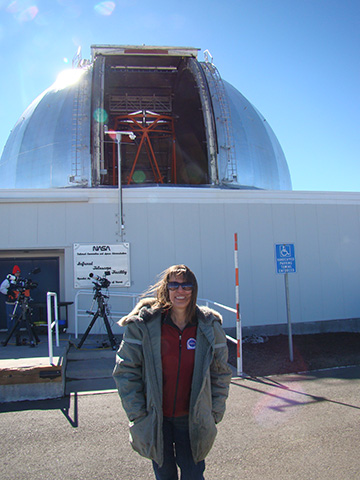
NASA scientist and program manager Kelly Fast, in front of the NASA Infrared Telescope Facility (IRTF) on Mauna Kea, Hawaii. [Image: Courtesy of K. Fast]
“Even though NASA is about missions, you can only put so many instruments on a spacecraft,” says Kelly Fast, the program manager for near-earth object (NEO) observations and the lead discipline scientist for solar system observations at the U.S. National Aeronautics and Space Administration (NASA). “You get a certain vantage point from the spacecraft. But complementing and supporting all of that from the ground—to get context, fill in wavelengths that aren’t covered on the spacecraft, catch things that maybe the spacecraft doesn’t see—that’s a very valuable way to expand on the science that comes from the mission.”
Probing Titan’s winds
Fast should know. “I was actually a ground-based astronomer before I came to NASA headquarters and became a bureaucrat,” she laughs. And in that earlier role, she participated as a team member in one scientific campaign where ground-based facilities played a key part. That campaign helped to ensure the success of what some view as the Cassini/Huygens mission’s crowning achievement: dropping the Huygens probe successfully to the surface of Titan in 2005, to return data from that alien world.
The Huygens part of Cassini/Huygens was an international undertaking led by the European Space Agency (ESA), and was a large part of the reason that the mission was funded at all. But, as NASA emeritus scientist (and OSA member) Ted Kostiuk—who had a long career as an astrophysicist at the Goddard Space Flight Center in Greenbelt, Md. (USA)—notes, there was a big “if” surrounding Huygens, involving the winds in the moon’s atmosphere.
“The goal is to maintain communications between the orbiter and the probe,” Kostiuk explains. “But if the wind is strong enough and if you don’t know its direction in advance, you have the risk that the probe will go into eclipse, and you won’t be able to track the probe and get data once it lands.” The team had “a pretty good idea” of the wind’s speed on Titan from thermal modeling, he says—but that modeling couldn’t say anything about the wind’s direction.
Heterodyne detection to the rescue
To help solve the problem, Kostiuk and his team turned to a technique with which they had already demonstrated success in measuring the wind speed on the planet Venus: thermal-infrared heterodyne detection. In this technique—adapted from radio receivers—ground-based infrared telescopes pick up the light from space, and mix it with output from a local oscillator of known, absolute frequency—a laser. The team then measures the difference frequency between the laser and the light coming in; that difference frequency, which falls in the radio region of the spectrum, preserves information on the infrared signal’s frequency and intensity that can be extracted and analyzed using well-established RF signal-processing tools.
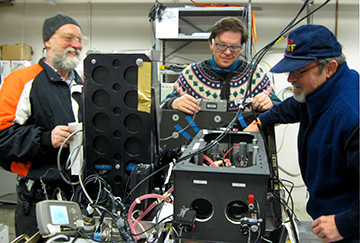
Ted Kostiuk (right), with colleagues John Annen and Tim Livengood, adjust one of the laser local oscillators used for infrared heterodyne detection at IRTF. [Image: Courtesy of T. Kostiuk]
For the studies of Titan, Kostiuk’s team used equipment at the NASA 3-meter Infrared Telescope Facility (IRTF) and, later, the Japanese National Astronomical Observatory’s 8.2-meter Subaru facility, both located on the heights of Mauna Kea, Hawaii (USA). The key to making the system work, Kostiuk says, lay in the bandwidth of the photomixer and in the frequency covered by the laser—in this case, CO2 lasers which, depending on the carbon isotope used, cover a very small slice of the frequency range from around 9 to 12 microns.
The system and the heterodyne technique, says Kostiuk, enabled the team to have “spectral resolution orders of magnitude better than any other spectral technique in this wavelength band.” And that allowed the team to measure the Doppler shift of infrared radiation emitted by wind-driven ethane molecules in Titan’s atmosphere—and thereby to measure the wind direction “very accurately,” according to Kostiuk.
The team made measurements of Titan’s winds in several campaigns in the late 1990s and early 2000s, including one during the actual descent of the Huygens probe. The data from these campaigns, along with observations and data from an array of other international facilities, helped the probe to stick a perfect landing on Titan, 934 million miles from Earth, and to send a precious stream of data back from the surface to the Cassini orbiter for 72 minutes before the orbiter moved out of range and the lander’s batteries gave out.
Kostiuk stresses that the heterodyne technique is “not new”—it was first developed by Charles Townes and his students in the 1970s, and has not changed too much since then. All the same, measuring the Doppler shift and getting the direction of Titan’s winds was something that Cassini, even right on the spot, simply couldn’t do, as the resolving power of its own infrared spectrometer, CIRS, was four orders of magnitude lower than that of the ground-based instruments. “From the ground, you can use much more sophisticated instruments,” Kostiuk says, “and they enable you to look at complementary issues and get complementary data.”
Adaptive optics
The work of Kostiuk’s team was just one component in large, coordinated campaign of Earth-based observation supporting the Huygens landing. That campaign included 17 radio telescopes in the United States, Japan, China and Australia and eight optical telescopes operated or jointly operated by NASA, ESA, ESO, and other worldwide agencies. These Earth-based scopes tracked the Huygens probe, picked apart the temperature, winds and composition of Titan’s atmosphere, and generally enriched the scientific harvest from the Huygens component of the mission.
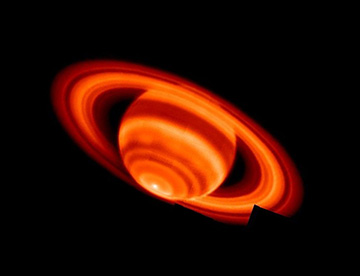
Mosaic false-color image of thermal heat emission from Saturn and its rings taken on 4 February 2004, with the Keck I telescope. [Image: W. M. Keck Observatory/NASA/JPL-G. Orton]
Among the telescopes participating in the Huygens mission, and in other observations supporting Cassini, have been the two 10-m telescopes at the W.M. Keck Observatory, also at the summit of Mauna Kea in Hawaii. Keck also contributed sharp images and spectra from Saturn’s rings and from other features.
In addition to the telescopes’ large aperture, Keck’s results benefited from another relatively recent innovation in optical technology: adaptive optics—the active shaping of the observed wavefront to subtract out distortions from Earth’s atmosphere. Keck does this through ground-based lasers that excite sodium atoms in the middle atmosphere to create artificial “guide stars,” which in turn are used to shape a deformable mirror that counteracts atmospheric turbulence.
Sending a spacecraft like Cassini to explore “is obviously very powerful,” says Randy Campbell, the observing support manager at Keck. “But those missions are limited in time. One thing that Keck and other ground-based telescopes have is the ability to look at things over time. It’s another piece of the puzzle that goes toward explaining the whole.”
Technological advances
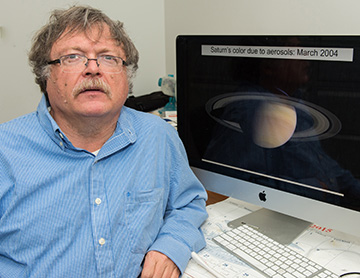
NASA investigator Gordon Bjoraker, who served as a co-investigator on Cassini's CIRS spectrometer and also worked on ground-based mission support. [Image: NASA/W. Hrybyk]
Keck’s adaptive optics suggest another plus of ground-based observations: they can take advantage of the march of technology.
The technology that goes into a deep-space mission “gets frozen well before launch, when the spacecraft is being developed,” observes NASA’s Kelly Fast. “So especially with a long-term mission like Cassini”—which is, in essence, stuck with state-of-the-art technology from the mid-1990s—“technology continues to develop here on the ground, and that’s another way that the ground-based work can complement something like Cassini.”
One example of this is a new instrument at NASA’s IRTF that was unveiled less than a year ago, at the tail end of Cassini’s voyage. This new tool, the iSHELL, includes a cryogenically cooled, 1.1-to-5.4-micron cross-dispersed immersion grating spectrograph and imager. According to Gordon Bjoraker, a co-investigator on the Cassini CIRS unit who also has worked on ground-based observations supporting the mission, iSHELL will offer a huge jump in spectral resolution relative to its precursor at the facility, an echelle spectrograph known as cSHELL.
“To give you an idea of how much the technology advanced,” Bjoraker says, “cSHELL, which came on line around 1992, had a 256×256-element detector array. The iSHELL detector is 2048×2048. It’s absolutely amazing.” Helping to make that advance possible, he adds, was a “very innovative design” that included high-refractive-index immersion gratings that allow the light to be bent in a more compact space. “Otherwise,” he says, “you’d have something the size of a school bus, and you can’t bolt a school bus on the back of a telescope.”
A storm’s aftermath
Initially, Bjoraker says, some of iSHELL’s work will likely involve supporting another outer-planet mission, the Juno probe, which is currently orbiting Jupiter. It’s hoped that the high spectral resolution of iSHELL will help to tease out the amount of oxygen in the jovian atmosphere, a major missing puzzle piece in numerical models.
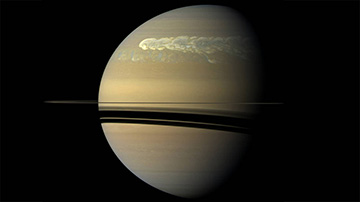
Cassini captured this image of a vast storm on Saturn, an area that future ground-based observations will continue to study. [Image: NASA]
Yet iSHELL will also play a role in further extending the scientific trail blazed by Cassini at Saturn. For example, one of the most iconic pictures from the Cassini mission shows a vast atmospheric storm, which developed in 2010 and 2011 in Saturn’s upper hemisphere and ultimately spread all the way around the planet. Cassini “was in the right place at the right time” to catch that storm, says Bjoraker, who notes that the event was vast enough to substantially change the composition and humidity measured at that part of the planet.
“We want to monitor that region, which is starting to cloud up again,” Bjoraker says, “and we can do that with iSHELL.” The new spectrograph will also expand on studies of Titan, as will measurements at other ground-based facilities such as the Atacama Large Millimeter/submillimeter Array (ALMA) in Chile.
A long (Saturnian) year
Bjoraker, who has been involved in both spacecraft-based and ground-based investigations, is in a particularly good position to see the value of both sides. “Spacecraft get all of the attention because they’re ‘up close and personal,’ sport a lot of cameras, and so forth,” he says. “You really can’t beat going there in person. But the upshot is that you can’t send into space as sophisticated an instrument as you can build on the ground. So I think they’re nicely complementary.”
And, suggests Kelly Fast, Saturn and its neighbors will still provide plenty of grist for Earth-based observations, even in the absence of a spacecraft on the scene. “A year on Saturn is about 30 Earth years,” she says. “It takes a long time for Saturn to complete its seasonal cycles. So there’s lots of science that can be done on a longer time scale than we had with Cassini, or with any single mission”—though Fast acknowledges that, in an environment of scarce resources, the scientific community has to make the case for those continued observations.
“What Cassini saw, even though it was a nice, long snapshot in time, was just that—a snapshot,” says Fast. “So there’s still more to see.”
